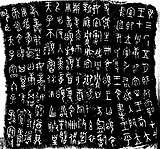
Back Цзіньвэнь Byelorussian Nápisy na bronzu Czech Bronzeinschrift German Escritura en bronce Spanish Style bronze French 金文 GAN Bronz-írás Hungarian Iscrizioni cinesi in bronzo Italian 金文 Japanese 금문 Korean
| Chinese bronze inscriptions | |||||||||||||||||||||||||
|---|---|---|---|---|---|---|---|---|---|---|---|---|---|---|---|---|---|---|---|---|---|---|---|---|---|
 Inscription on the Song ding, c. 800 BC | |||||||||||||||||||||||||
| Chinese name | |||||||||||||||||||||||||
| Chinese | 金文 | ||||||||||||||||||||||||
| Literal meaning | Bronze writing | ||||||||||||||||||||||||
| |||||||||||||||||||||||||
| Alternative Chinese name | |||||||||||||||||||||||||
| Traditional Chinese | 鐘鼎文 | ||||||||||||||||||||||||
| Simplified Chinese | 钟鼎文 | ||||||||||||||||||||||||
| Literal meaning | Bell and cauldron writing | ||||||||||||||||||||||||
| |||||||||||||||||||||||||
| Japanese name | |||||||||||||||||||||||||
| Kanji | 金文 | ||||||||||||||||||||||||
| Hiragana | きんぶん | ||||||||||||||||||||||||
| Katakana | キンブン | ||||||||||||||||||||||||
| |||||||||||||||||||||||||
Chinese bronze inscriptions, also commonly referred to as bronze script or bronzeware script, are writing in a variety of Chinese scripts on ritual bronzes such as zhōng bells and dǐng tripodal cauldrons from the Shang dynasty (2nd millennium BC) to the Zhou dynasty (11th–3rd century BC) and even later. Early bronze inscriptions were almost always cast (that is, the writing was done with a stylus in the wet clay of the piece-mold from which the bronze was then cast), while later inscriptions were often engraved after the bronze was cast.[1] The bronze inscriptions are one of the earliest scripts in the Chinese family of scripts, preceded by the oracle bone script.
- ^ Qiú 2000 p.60
© MMXXIII Rich X Search. We shall prevail. All rights reserved. Rich X Search
